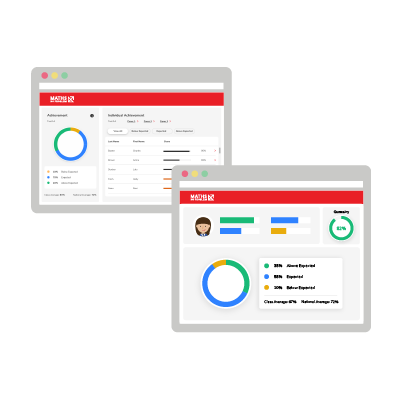Know the basics of formative and summative assessment
Editor’s Note:
This is an updated version of a blog post published on October 29, 2020
To develop an informed understanding of where children are in their learning, you need to understand the basics. So what is formative and summative assessment? And how can you use them in your classroom?
We frequently use the word assessment as an umbrella term to encompass a number of different purposes. Our approach to assessment tends to be multifaceted, including both formative and summative assessment. Each is defined by how we are using it and what we are using it to assess.
Here are the primary assessment need-to-knows.
What is formative assessment?
Formative assessment can be thought of as our day-to-day, real time assessment. Often we define it as Assessment for Learning, with the purpose of using it to inform the learning moving forward.
Formative assessment is continuous, typically informal and constant throughout a lesson. This means that a core role for the teacher throughout the lesson is to be constantly assessing each child’s progress towards understanding the objective of the lesson.
Effective formative assessment requires teachers to be flexible and willing to adapt to learning blocks or opportunities for challenge as they appear throughout the lesson.
Examples of formative assessment within Maths — No Problem!
Formative assessment can be both formal or informal and may take a range of forms. Here are some examples of what it can look like in the Maths — No Problem! Programme.
Using effective questioning
Asking key questions throughout the lesson helps you check for understanding, identify progress and diagnose the root cause of an incorrect answer.
Making classroom observations
There are a number of opportunities in a Maths — No Problem! lesson to check for understanding that can either be addressed instantly or as a whole class. For example, the anchor task, activity time or journaling.
Introducing plenary questions or activities
Plenary questions or activities check whether learners are ready to move on at the end of the lesson. With Maths — No Problem! learners complete independent work that progressively requires a deeper level of understanding. This carefully structured work allows you to easily gauge how well a child understands the lesson’s objective by how much of the independent work they are able to complete.
Implementing quick check routines
Some teachers choose to implement a quick check routine where children use a signal, such as a thumbs up to show a learner’s level of confidence and help teachers with the pitch of the lesson. This quick scan can determine next steps, like whether the majority of the class can go away and complete independent work while those few still unsure can continue in a guided setting with the teacher or their peers.
Transform your maths assessment
Insights — our online assessment tool — gives you instant, powerful data to identify gaps and improve results.

DuFour’s 4 critical questions
The golden rule of formative assessment is it needs to have a purpose and the information gathered needs to inform the learning.
To prevent formative assessment from merely being a formality, planning for formative assessment outcomes by using Richard Dufour’s 4 critical questions can be useful. When lesson planning I find these can be scaled back and adapted to the context of an individual lesson and thought about as an effective formative assessment planning tool.
What are DuFour’s 4 critical questions?
- What do we want all students to know and be able to do
- How will we know if they learn it?
- How will we respond when some students do not learn?
- How will we extend the learning for students who are already proficient?
Being clear about these questions and planning for how you will respond to these outcomes during lessons will help ensure you are meeting the needs of all learners in real time and the response to formative assessment is more effective.
Throughout a maths lesson, it’s your role to monitor children’s understanding of the learning to ensure any misconceptions are being addressed in the moment.
At the conclusion of the maths lesson, it’s important to check how secure learners are with the objective and then use this to inform further intervention work if necessary.
What is summative assessment?
Summative assessment can best be characterised as Assessment of Learning. We usually use this as a way of assessing a child’s progress in meeting specific objectives either after a unit of work has been completed, or at the end of a term or year.
What are the advantages of summative assessment?
Summative assessments are usually periodic and often we use it as a way to validate our formative assessment practices. It is important to remember they are often only a snapshot of a child’s progress on the given day but they are effective in quantifying achievements as we are comparing the child’s success with a set of goals.
You shouldn’t assume that if it’s a test it’s also a summative assessment. Quiz questions or tests can be used for formative assessment, the difference lies in what your objective is.
Is it Assessment for Learning or Assessment of Learning?
When should you assess?
It is important to be aware that when you assess a child is a significant factor in developing an accurate overall picture because assessing performance can be different from assessing learning.
At the end of a series of lessons, often we feel reasonably confident that we know each child’s level of understanding based on both the formative and summative assessments carried out. Like if they have performed well in the end of unit review.
However, this can be a false sense of achievement as often we have only assessed a child’s current performance.
Often we can find that if we tested them again on the content in a few weeks time they won’t remember how to do it because everyone forgets content over time. If we want children to commit information to their long-term memory, they need to be given opportunities to retrieve the information after various amounts of time.
This doesn’t mean you need to be constantly testing, but retrieval activities could be worked into your maths lessons so learners are moving information from their working memory into their long term memory. This will help to ensure when you assess learning your summative assessments should more accurately reflect the formative and current performance assessments.
Both formative and summative assessment are important tools in helping learners to progress their learning. Children should develop an understanding that assessment is important in supporting their learning and is not there as a label of what they can and can’t do, but as an indicator of where to go next. The effectiveness of formative and summative assessments can depend largely on how much we use them to inform our teaching and learning moving forward

